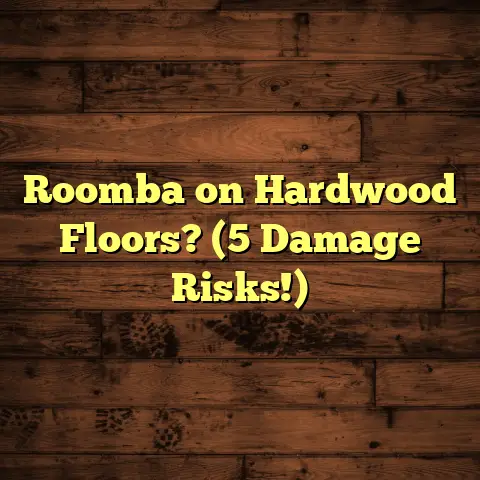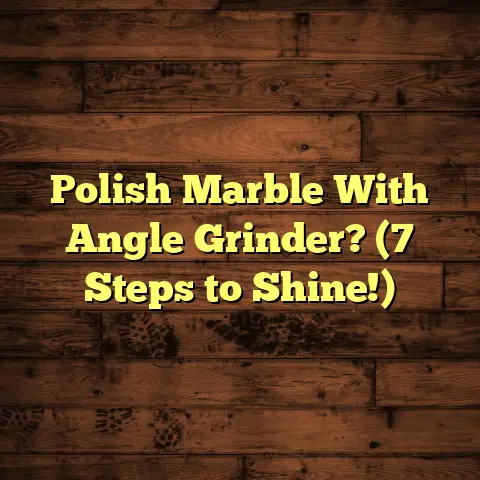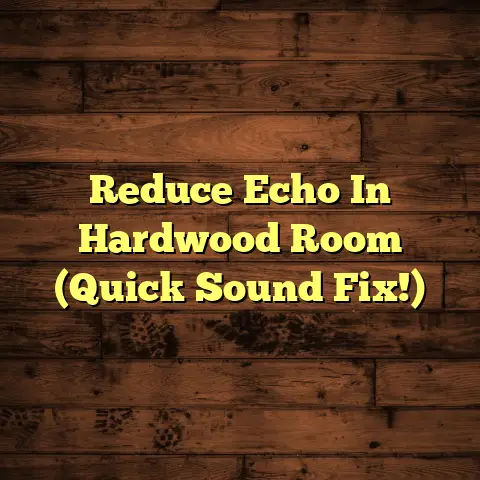Wood Floor Finishes: Types? (4 Pro Choices!)
Ever walk into a room and just feel the warmth and elegance radiating from the floor?
That’s the magic of wood flooring, my friend, and it’s a lifestyle upgrade like no other.
I’ve seen firsthand how a beautiful wood floor can transform a house into a home.
It’s not just about aesthetics; it’s about creating a space that feels inviting, sophisticated, and uniquely yours.
And trust me, the right finish is the key to unlocking that potential.
Let’s dive into the world of wood floor finishes and find the perfect match for your space!
Section 1: Understanding Wood Floor Finishes
1. Definition and Purpose of Wood Floor Finishes
So, what exactly is a wood floor finish?
Think of it as a protective shield for your precious wood, like a superhero cape against daily wear and tear.
But it’s not just about protection.
A good finish also enhances the natural beauty of the wood, bringing out its grain and color.
It’s the difference between a dull, lifeless floor and one that shines with character and warmth.
Without a finish, your wood floors are vulnerable to moisture, scratches, and stains.
The finish acts as a barrier, preventing liquids from soaking into the wood and causing damage.
It also provides a smooth, durable surface that can withstand daily foot traffic.
2. The Science Behind Wood Finishes
Ever wonder how these finishes actually work?
It’s all about the interaction between the finish and the wood itself.
Different finishes have different levels of absorption, meaning they penetrate the wood to varying degrees.
This absorption helps to protect the wood from within, creating a long-lasting barrier against moisture and UV damage.
Most finishes are composed of oils, solvents, and additives.
The oils provide the protective layer, while the solvents help the finish to spread evenly and penetrate the wood.
Additives can enhance the finish’s durability, UV resistance, or even add color.
For example, polyurethane finishes form a protective film on the surface, while penetrating oils soak into the wood fibers.
UV inhibitors are often added to prevent the finish from yellowing or fading over time.
Section 2: Types of Wood Floor Finishes
Alright, let’s get to the fun part: exploring the different types of wood floor finishes.
I’m going to share my top four pro choices, based on years of experience in the field.
1. Oil-Based Polyurethane Finishes
Ah, the classic choice!
Oil-based polyurethane is known for its durability and the warm, amber hue it imparts to wood floors.
It’s like wrapping your floors in a cozy blanket of color.
Advantages:
- Durability: This stuff is tough! It can withstand heavy foot traffic and resist scratches and scuffs.
- Warm Tone: Oil-based poly gives your floors a rich, amber glow that many homeowners love.
- Water Resistance: It provides excellent protection against spills and moisture.
Disadvantages:
- High VOCs: Oil-based finishes release volatile organic compounds (VOCs), which can be harmful to your health and the environment.
- Long Drying Time: It can take a while for oil-based poly to fully cure, meaning you’ll have to stay off your floors for longer.
- Yellowing: Over time, oil-based poly can yellow, especially in areas with lots of sunlight.
I’ve used oil-based polyurethane in countless homes, especially in living rooms and dining rooms where durability and a warm aesthetic are key.
2. Water-Based Polyurethane Finishes
If you’re looking for a more eco-friendly option, water-based polyurethane is a great choice.
It has low VOC content and dries much faster than oil-based poly.
Plus, it’s crystal clear, so it won’t alter the natural color of your wood.
Advantages:
- Low VOCs: Water-based poly is much better for the environment and your health.
- Fast Drying Time: You can usually walk on your floors within 24 hours of application.
- Non-Yellowing: It stays clear over time, preserving the natural color of your wood.
Disadvantages:
- Less Durable: While still durable, water-based poly isn’t quite as tough as oil-based.
- Higher Cost: It tends to be more expensive than oil-based polyurethane.
- Can Raise Grain: Water in the product can sometimes raise the grain of the wood, requiring more sanding.
I often recommend water-based polyurethane for bedrooms and kitchens, where low VOCs and a natural look are desired.
3. Penetrating Oils
Want to really show off the natural beauty of your wood?
Penetrating oils are the way to go.
These finishes soak into the wood, highlighting the grain and creating a soft, matte finish.
Advantages:
- Natural Look: Penetrating oils enhance the wood’s natural beauty, creating a warm, inviting atmosphere.
- Easy to Repair: Scratches and scuffs can be easily repaired with a fresh coat of oil.
- Eco-Friendly: Many penetrating oils are made from natural, sustainable ingredients.
Disadvantages:
- Less Durable: Penetrating oils don’t provide as much protection as polyurethane finishes.
- Requires More Maintenance: You’ll need to reapply oil more frequently to maintain the finish.
- Not Water Resistant: Penetrating oils don’t offer as much protection against spills and moisture.
I love using penetrating oils in rustic or farmhouse-style homes, where the natural look and feel are paramount.
4. Aluminum Oxide Finishes
If you’re all about durability, aluminum oxide finishes are the ultimate choice.
These finishes are factory-applied and incredibly resistant to scratches, scuffs, and UV damage.
They’re like giving your floors a suit of armor!
Advantages:
- Extreme Durability: Aluminum oxide finishes are the most durable option available, perfect for high-traffic areas.
- Scratch Resistance: They’re highly resistant to scratches and scuffs, making them ideal for homes with pets or kids.
- UV Resistance: They won’t fade or yellow over time, even in direct sunlight.
Disadvantages:
- Difficult to Refinish: Aluminum oxide finishes are very hard to sand and refinish, so repairs can be tricky.
- Factory Applied: These finishes are typically applied at the factory, limiting your color and finish options.
- Can Look Artificial: Some homeowners find aluminum oxide finishes to look less natural than other options.
I often see aluminum oxide finishes in commercial spaces or homes with very active families, where durability is the top priority.
Section 3: Choosing the Right Finish for Your Lifestyle
Okay, now that you know the different types of finishes, how do you choose the right one for your space?
It’s all about considering your lifestyle, aesthetic preferences, and the specific needs of your home.
1. Evaluating Your Space
Think about the following factors when choosing a wood floor finish:
- Foot Traffic: How much traffic does the area get? High-traffic areas like hallways and kitchens need more durable finishes.
- Pets: Do you have pets? Scratches from claws can wreak havoc on less durable finishes.
- Kids: Kids can be tough on floors! Choose a finish that can withstand spills, toys, and general wear and tear.
- Design Style: What’s your overall design style? A rustic farmhouse might call for penetrating oils, while a modern condo might look best with water-based polyurethane.
- Lighting: How much natural light does the room get? Some finishes can yellow or fade in direct sunlight.
2. Comparative Analysis of the Four Pro Choices
To help you make a decision, here’s a handy comparison table:
| Feature | Oil-Based Poly | Water-Based Poly | Penetrating Oil | Aluminum Oxide |
|---|---|---|---|---|
| Durability | Excellent | Good | Fair | Extreme |
| VOCs | High | Low | Low | Low |
| Drying Time | Slow | Fast | Medium | N/A |
| Appearance | Warm, Amber | Clear | Natural, Matte | Varies |
| Maintenance | Low | Low | High | Very Low |
| Best For | Living Rooms | Bedrooms | Rustic Homes | High-Traffic |
| Cost | Moderate | High | Moderate | High |
For example, if you have an active household with kids and pets, aluminum oxide or oil-based polyurethane would be a great choice.
If you’re looking for an eco-friendly option for a low-traffic area, water-based polyurethane or penetrating oil might be a better fit.
Section 4: Application Techniques and Tips
So, you’ve chosen your finish. Awesome!
Now, let’s talk about how to apply it like a pro.
1. Preparation for Application
Proper preparation is key to a flawless finish.
Here’s what you need to do:
- Clean the Floor: Remove all dirt, dust, and debris from the floor. I recommend vacuuming and then using a damp mop with a wood floor cleaner.
- Sand the Floor: Sanding removes any existing finish and creates a smooth surface for the new finish to adhere to. Start with a coarse grit sandpaper and gradually move to finer grits.
- Vacuum Again: After sanding, vacuum the floor thoroughly to remove all sanding dust.
- Tack Cloth: Use a tack cloth to pick up any remaining dust particles.
- Choose the Right Tools: Use high-quality brushes, rollers, or applicators designed for the type of finish you’re using.
2. Application Process
Here’s a step-by-step guide to applying each type of finish:
-
Oil-Based Polyurethane:
- Stir the finish gently to avoid creating bubbles.
- Apply a thin, even coat using a brush or roller.
- Allow the finish to dry completely (usually 24-48 hours) before applying the next coat.
- Lightly sand between coats to remove any imperfections.
- Apply 2-3 coats for optimal durability.
-
Water-Based Polyurethane:
-
Follow the same steps as oil-based poly, but be sure to use a synthetic brush or roller.
- Water-based poly dries faster, so you can usually apply multiple coats in a single day.
-
Penetrating Oils:
-
Apply the oil liberally to the floor using a brush or cloth.
- Allow the oil to soak into the wood for 15-20 minutes.
- Wipe off any excess oil with a clean cloth.
- Allow the oil to dry completely (usually 24 hours) before applying another coat.
- Apply 2-3 coats for optimal protection.
Common Mistakes to Avoid:
- Applying Too Much Finish: This can lead to uneven drying and a sticky surface.
- Skipping Sanding: Sanding is essential for creating a smooth, even surface.
- Not Cleaning the Floor Properly: Dust and debris can get trapped in the finish, creating imperfections.
- Using the Wrong Tools: Using the wrong brush or roller can result in streaks and uneven coverage.
3. Curing and Maintenance
Once you’ve applied the finish, it’s important to allow it to cure properly.
Curing is the process by which the finish hardens and becomes fully durable.
- Oil-Based Polyurethane: Allow 7-10 days for full curing.
- Water-Based Polyurethane: Allow 3-5 days for full curing.
- Penetrating Oils: Allow 24-48 hours for each coat to dry completely.
Routine Maintenance:
- Sweep or vacuum regularly to remove dirt and debris.
- Use a damp mop with a wood floor cleaner to clean the floor.
- Avoid using harsh chemicals or abrasive cleaners.
- Place rugs in high-traffic areas to protect the finish.
- Reapply penetrating oil every 1-2 years to maintain the finish.
Conclusion: The Lasting Impact of Choosing the Right Finish
Choosing the right wood floor finish is a big decision, but it’s one that can have a lasting impact on your home.
The right finish not only enhances the beauty and functionality of your floors but also contributes to the overall quality of life in your home.
I’ve seen firsthand how a well-chosen finish can transform a space, creating a warm, inviting, and stylish atmosphere.
So, take your time, consider your options carefully, and make a choice that reflects your personal style and lifestyle needs.
Trust me, you’ll be glad you did!





